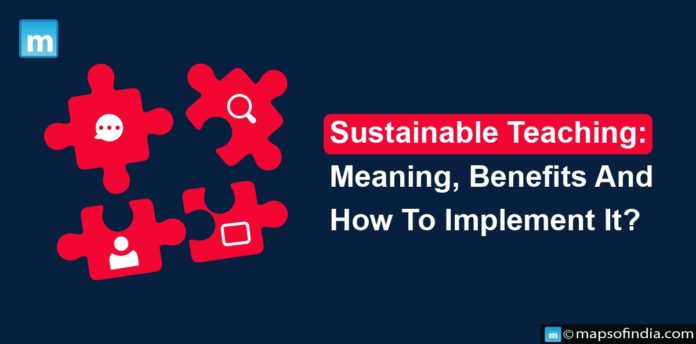Sustainable teaching is the discipline of preparing students for lifetime learning outside of the classroom. This innovative instructional approach emphasizes essential soft skills and academic knowledge. It is a comprehensive educational strategy that prepares students to be lifelong learners, responsible citizens, and creative problem solvers. It includes various teaching techniques to encourage critical thinking, innovation, and sustainability literacy.
Benefits of Sustainable Teaching
Here are a few strong arguments why sustainable teaching is a good and necessary practice:
-
Lifelong Learning Skills
Critical thinking, research, cooperation, and presentation skills are all emphasized in sustainable teaching. These abilities are not just valuable for academic contexts, but they are also necessary for success in other areas of life.
-
Real-World Relevance
Sustainable teaching makes education more relevant to students’ lives by including sustainability issues into the curriculum. The emphasis on real-world problems develops a sense of purpose by linking academic learning to practical applications and prepares students to face global difficulties.
-
Adaptability and Innovation
Sustainable teaching fosters adaptation and innovation through project-based learning and problem-solving activities. Students learn to address issues with creativity, resilience, and a willingness to try new approaches, which are essential abilities in the continually changing terrain of the twenty-first century.
-
Intrinsic Motivation
They find significant and impactful, sustainable teaching frequently taps into students’ intrinsic motivation by tying their learning to topics. Students are more likely to be engaged, curious, and self-directed in their learning journey when they see the real-world applicability of their education.
How to implement Sustainable Teaching in classrooms?
Here are some practical methods to implement sustainable teaching in classes:
-
Critical Thinking
Encourage students to ask open-ended, critical-thinking questions. Ask thought-provoking questions that require information processing, appraisal, and synthesis. Organize debates or class discussions on current topics. Assign roles that require students to evaluate multiple points of view and to defend their opinions with evidence.
-
Research Skills
Design projects that require extensive research. Assist students in finding credible sources, analyzing information, and synthesizing findings. Teach students how to use libraries and online databases successfully. Show students how to identify reputable sources and reference information correctly.
-
Collaboration
Assign collaborative assignments that are modeled after real-world scenarios. Assure that different roles are played within groups, encouraging the interchange of ideas and the development of collaborative skills. To facilitate virtual communication, use online platforms. Encourage students to collaborate on shared papers, participate in online discussions, and interact with classmates outside the classroom.
-
Presentation Skills
Include activities that will help students improve their public speaking skills. Short speeches, debates, or even narrative exercises can be included. Give students constructive comments to help them develop their communication skills. Investigate various presentation formats, such as slideshows, movies, and infographics. This not only accommodates multiple learning styles but also prepares students for a variety of communication channels in the digital age.
Educators can build an environment that imparts knowledge and equips students with the necessary skills for lifetime learning by adopting these strategies. Sustainable education emerges as an essential element in developing the brains that will lead us to a more inclusive, innovative, and responsible global society.




